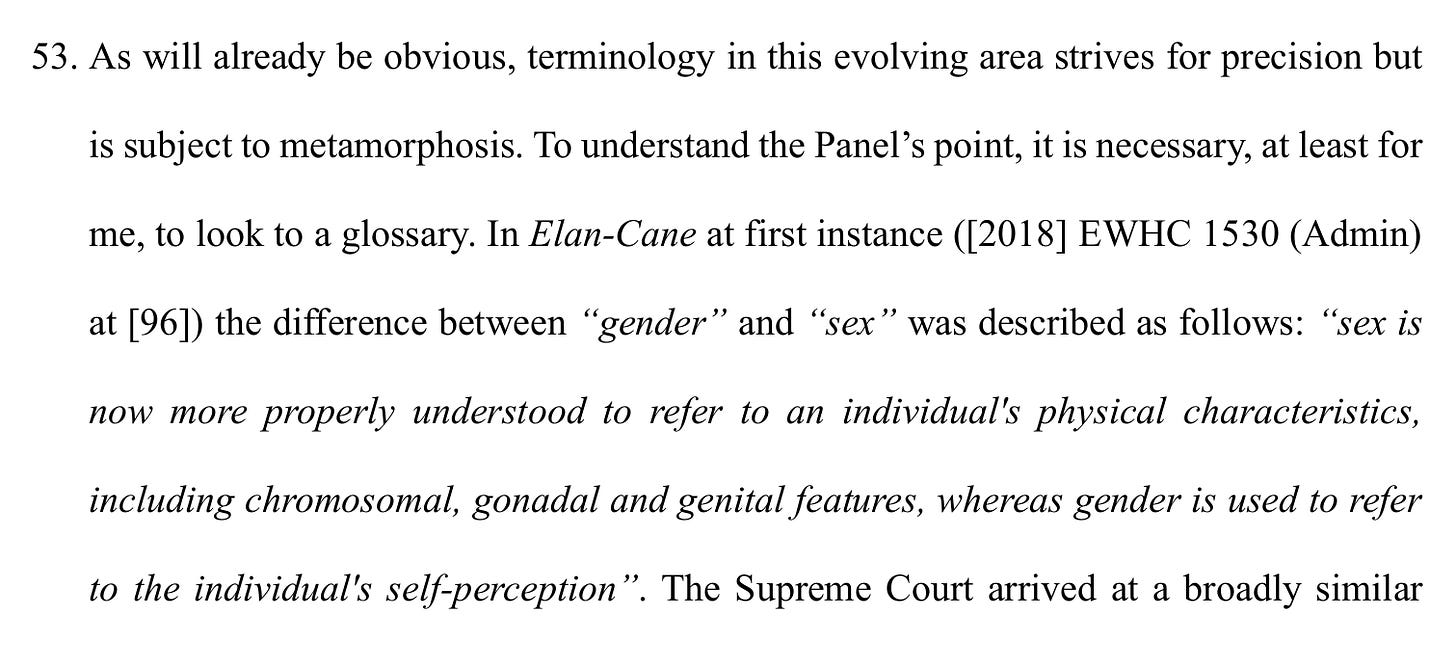W v Gender Recognition Panel - PART TWO
How mothers can be men
Starting to find this judge’s pretentious language a bit grating. I am sure he meant the language is developing, not undergoing a metamorphosis. It is also not clear whether he correctly identifies the distinction between the cultural and social use of the word gender and its meaning in law, for which a reference to the Istanbul Convention is necessary. In the Convention, at Article 3, gender is defined as follows
In point of fact, the very opposite of self-perception; rather, the societal constraints (of which women are mostly victims) imposed on men and women. There is no evidence that gender signifies self-perception; gender identity is taken to have that meaning, and that is precisely the sleigh of hand I explained in my monograph on gender identity, whereby stereotypes of femininity and masculinity are ennobled by transforming them into signifiers of self-perception and personal identity instead of social constraints on the sexes.
The Supreme Court is equally lacking in precision and a proper grounding of the term in the international context, applicable to UK law as the UK is a Contracting Party of the Istanbul Convention:
Judge Hayden makes the same mistake of which the UKSC is guilty, ie considering sex and gender as interchangeable in the GRA
In fact, this is not the case. In the GRA the word sex appears only once, in s9, with reference to the language of birth certificates. Everywhere else the Act uses the word gender, without ever determining its meaning. In any event, while gender can sometimes be used as a euphemism for sex, sex is never used as a substitute for gender, so the two words are not interchangeable, because there is no reciprocity. It is getting tiresome to see judges repeat this mistake over and over again, and to see parroted by legal scholars who present themselves as experts in this area of law (a buon intenditor, poche parole). Finally, it is clear by now that this replacement was not innocent but was engineered specifically to erase sex as a protected category, so really, we can do without these Pollyanna judges refusing to see what is done under their noses while they earnestly talk about her penis and his pregnancy, as if this perversion of reality does not affect their status and the very integrity of the rule of law.
Certified sex is of course a legal abomination, but one that this Judge is happy to adopt. There is no such thing as certified sex. The GRC grants an acquired gender, not a certified sex.
This is not, to my knowledge, the distinction between the terms as it is normally understood in legal theory, which pertains to the distinction between permissive norms, ie norms that permit a certain behaviour, and prescriptive norms, ie norms that dictate a certain behaviour (either positively, dictating that something is done, or negatively, that something is prohibited). I think rather the Judge here intends to draw a distinction between rules being read restrictively or not. I have to say this sloppiness does not inspire confidence, especially because it infects the next section of the judgment, where the Judge tackles the meaning of living in the acquired gender. This is the beginning:
Again, the GRA is not permissive in the plain meaning of the legal term, in the sense that it does not allow a certain behaviour. What he means is that it enjoins the state not to read restrictively the criteria for granting a GRC, and that is what should animate the textual reading of the phrase ‘living in the acquired gender’. A plain reading would give a rough meaning of ‘living in accordance to the stereotypes and social rules associated with the opposite sex’.
There is instead a long detour about the possibility of there being male mothers and female fathers in accordance to the law, as expressed by the ECtHR and by UK law:
END OF PART TWO









https://ilonaragana.substack.com/p/father-has-not-seen-his-children